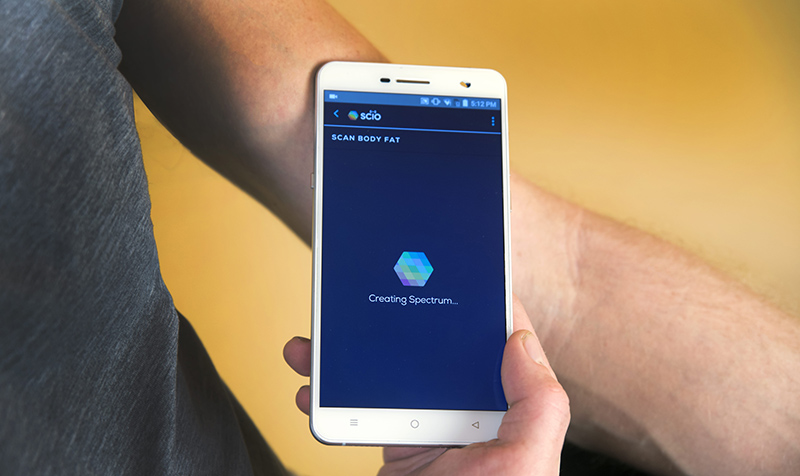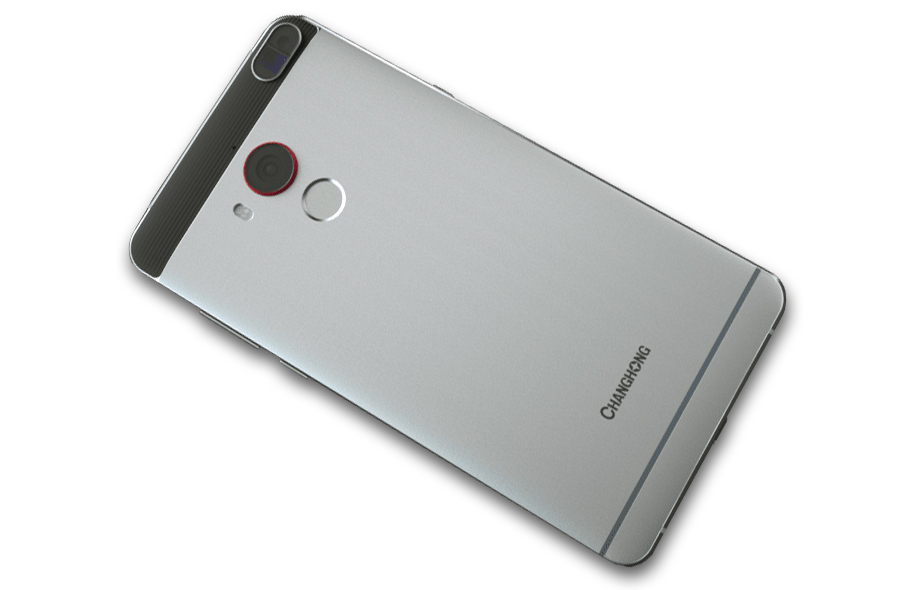SCiO Molecular Sensor Added to Smartphone: Reads Chemical Composition of Materials
by Matt Humrick on January 9, 2017 2:20 PM EST- Posted in
- Smartphones
- Mobile
- SCiO

I first saw Consumer Physics’ SCiO handheld scanner a couple of years ago and was impressed by its ability to identify materials by scanning and analyzing their chemical composition. In the intervening years, Consumer Physics has partnered with Analog Devices to increase the sensor’s accuracy and reduce its size, and at CES 2017, the company announced the first smartphone with an integrated SCiO sensor, making this technology even easier to carry and use.
The Changhong H2 has a 6-inch 1080p display and a 16MP rear camera. Inside is an octa-core CPU running at up to 2.0GHz paired with 4GB of RAM and 64GB of internal storage, all powered by a 3000mAh battery. The H2’s standout feature, though, is the new sensor.
The SCiO sensor uses near-infrared spectroscopy to identify a material’s molecular content. By illuminating an object with a broadband light source and using the spectrometer, a type of optical sensor, to break the reflected light into its constituent components, SCiO’s signal processing algorithms compare the reflected light’s wavelengths to the original emission to create a spectral fingerprint. This technique works because molecules will only absorb photons at certain energy levels, which means specific wavelengths will be missing or attenuated in the reflected light.
The Changhong H2’s sensor allows you to virtually “taste” food, measuring the sweetness of fruit for example, or measure how ripe fruits and vegetables are. It can identify specific liquids, tell you if the pills in an unmarked bottle are vitamins or a prescription pain killer, or even tell you if the Viagra you bought online from that sketchy website is real or fake. You can even use it to measure body fat and analyze the nutritional content of food.
The SCiO sensor module sits next to the camera on the back of the Changhong H2. Scanning an object involves opening an app and placing the sensor close to its surface, within 0.5-2.0 cm. It takes about 1.5 seconds to collect data. The app then compares the material’s spectral fingerprint to thousands of others stored in a cloud-based database for identification, as shown in the demonstration below.
Consumer Physics is working with companies to integrate its sensor into other products as well, such as the DietSensor scale—it also makes an app for the Changhong H2—that scans and weighs food to determine the calorie count and ratio between carbohydrates, fat, and protein. There’s also an SDK for third-party developers to develop apps that leverage the sensor’s capabilities.
The Changhong H2 will be available in China for 2999 RMB starting in June 2017 and will come to the US and other regions later in the year.













19 Comments
View All Comments
Morawka - Monday, January 9, 2017 - link
how long before apple buys this company? this is game changing tech right here. if they can continue to refine it, it will make the dream of having a Star Trek Tricorder real!BrokenCrayons - Monday, January 9, 2017 - link
Chemical sensors might be useful, but if the mechanisms for doing so become small and unintrusive (meaning outside of the perception of the person carrying the device) then it's likely they'll be active at times when the end user isn't aware in order to measure things near the device to enhance marketing through data mining. Now your phone will not only know where you are and what you're doing, but also what you just ate and how your farts smell. It's just additional information that really doesn't need to be collected and stored someplace outside your reach.JeffFlanagan - Monday, January 9, 2017 - link
We already have app permissions, and they're only becoming better over time. Maybe you're paranoid.HomeworldFound - Monday, January 9, 2017 - link
I fail to see how different that is to someone taking a picture of their meal and uploading it online. To gather information about your fart, you'll need to put the phone 0.5cm to 2cm from your backside and keep it there for 1.5 seconds.. basically you'd need to fart on your phone.ddriver - Monday, January 9, 2017 - link
You are being shortsighted here. If you want to "smell scan" a particular object, then sure, you must hold the phone next to it. But that's not necessary for smelling the "general vibe". Solid state chemical sensors are nothing new, what's new is they are getting affordable enough to become widespread. A plethora of solid state chemical sensors have been employed for a long time in the industry to protect from harmful gasses or to control machinery, and there never was a necessity that they'd be .5 to 2 cm from the source. That's only necessary if you want to focus on a particular object, and even then it will pick a variety of other molecules that are in lower concentration.I guess the "smelling a particular object" would be to pitch it to consumers, whereas its actually purpose would be to "spy on smells around consumers (and find ways to exploit that to make money). Pretty much like everything else.
And sure, we've long had app permissions, but even further back in time we've had that thing called "backdoors". Every manufacturer implements a variety of backdoors to grant "god mode" access to the device below the layer of app permissions when necessary. That's why not a single big corporation has 100% open source product. They hide stuff in their proprietary binary blobs, and if some of that would be discovered by accident, they will claim it was an overlooked vulnerability, and immediately offer a patch that will fix it so 3rd party players don't get to exploit it while also introducing another "vulnerability".
Reflex - Monday, January 9, 2017 - link
It's all true! And all of us kernel engineers keep the back doors secret. We are paid a ton of hush money so we don't reveal the secret even when we change jobs! Its why we all drive the latest Bugatti's. Plus they give us a lifetime supply of tinfoil to protect us from the results of all the other conspiracies the tens of thousands of us in the industry are a part of...AndrewJacksonZA - Tuesday, January 10, 2017 - link
Shhh Reflex! Why did you let the cat out of the bag?!?! ;-)close - Tuesday, January 10, 2017 - link
@Reflex, considering the host of revelations that came in the past years regarding manufacturer built backdoors and also ones slipped in by state actors (and not only) I wouldn't be so confident if I were you. It's not like you are responsible for every line of code of such complex software and can guarantee the integrity at every step.I know you want to think that the engineer is a little God in that world and that he has 100% control but the truth is he doesn't and he can't. If someone is determined enough "things" can get by and slip unnoticed except for the people who have to know.
And before you claim this is paranoia just be aware of the fact that it has already happened, it's not up for debate anymore, it's not an "if" issue. Fighting to "prove" it can't happen is just a matter of your ego.
Reflex - Tuesday, January 10, 2017 - link
Totally true! It's not like we don't all put our code into a central repository with a large cast of engineers and managers who have the ability to audit it. It's super secret, not even QA can verify it!The whole code repository is hosted on servers wrapped in multiple layers of tinfoil to prevent interference from 'them'....
Flunk - Monday, January 9, 2017 - link
They already did that, look up the "Vital Technologies TR-107 Tricorder Mark 1". It did cost a fortune and it did put it's manufacturer out of business, but they did build one.